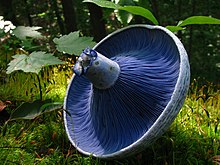| Lactarius indigo | |
|---|---|

| |
| The gills of L. indigo | |
| Scientific classification | |
| Domain: | Eukaryota |
| Kingdom: | Fungi |
| Division: | Basidiomycota |
| Class: | Agaricomycetes |
| Order: | Russulales |
| Family: | Russulaceae |
| Genus: | Lactarius |
| Species: | L. indigo
|
| Binomial name | |
| Lactarius indigo | |
| Synonyms | |
|
Agaricus indigo Schwein. (1822) | |
| Lactarius indigo | |
|---|---|
| Gills on hymenium | |
| Cap is depressed | |
| Hymenium is adnate or decurrent | |
| Stipe is bare | |
| Spore print is yellow | |
| Ecology is mycorrhizal | |
| Edibility is edible | |
Lactarius indigo, commonly known as the indigo milk cap, indigo milky, indigo lactarius, blue lactarius, or blue milk mushroom, is a species of agaric fungus in the family Russulaceae.
The fruit body color ranges from dark blue in fresh specimens to pale blue-gray in older ones. The milk, or latex, that oozes when the mushroom tissue is cut or broken (a feature common to all members of the genus Lactarius) is also indigo blue, but slowly turns green upon exposure to air. The cap has a diameter of 5–15 cm (2–6 in), and the stem is 2–8 cm (3⁄4–3+1⁄8 in) tall and 1–2.5 cm (3⁄8–1 in) thick.
It is a widely distributed species, growing naturally in eastern North America, East Asia, and Central America; it has also been reported in southern France. L. indigo grows on the ground in both deciduous and coniferous forests, where it forms mycorrhizal associations with a broad range of trees. It is an edible mushroom, and is sold in rural markets in China, Guatemala, and Mexico.